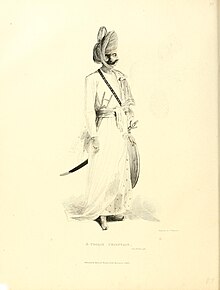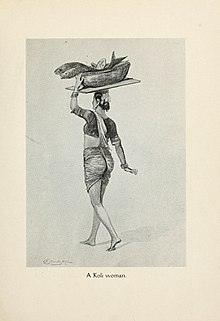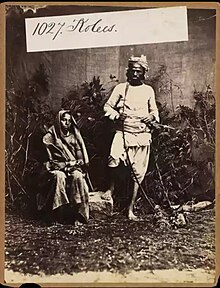Ethnic group
 A portrait of a Koli chieftain of Dahewan by James Forbes, 1813 A portrait of a Koli chieftain of Dahewan by James Forbes, 1813 | |
| Regions with significant populations | |
|---|---|
| Rajasthan, Himachal Pradesh, Gujarat, Maharashtra, Uttar Pradesh, Haryana, Karnataka,Odisha, Kashmir | |
| Languages | |
| Hindi, Gujarati, Marathi, Bhil, Kachi Koli, Konkani, Kannada | |
| Religion | |
| Hindu, Muslim, Christian | |
| Related ethnic groups | |
| Kori, Koli Christians, Baria |
The Koli is an Indian caste that is predominantly found in India, but also in Pakistan and Nepal. Koli is an agriculturist caste of Gujarat but in coastal areas they also work as fishermen along with agriculture.
In the beginning of 20th century, the Koli caste was recognised as a denotified tribe under Criminal Tribes Act by the Indian Government because of their anti-social activities during World War I. The Koli caste forms the largest caste-cluster in Gujarat and Himachal Pradesh, comprising 24% and 30% of the total population in those states respectively.
History
Early

There has historically been some difficulty in identifying people as Koli or as Bhil people in what is now the state of Gujarat. The two communities co-existed in the hills of that area and even today there is confusion regarding their identity, not helped, in the opinion of sociologist Arvind Shah, by there being "hardly any modern, systematic, anthropological, sociological or historical study" of the Kolis. Sources from the medieval period suggest that the term Koli was applied generically to lawless people, while British colonial studies considered it to be a vague collective noun for varied communities whose sole common feature was that they were inferior to the Kunbis. At some stage, Koli became accepted as a caste and thus superior to the tribal Bhils.
Records of Koli people exist from at least the 15th century, when rulers in the present-day Gujarat region called their chieftains marauding robbers, dacoits, and pirates. Over a period of several centuries, some of them were able to establish petty chiefdoms throughout the region, mostly comprising just a single village. Although not Rajputs, this relatively small subset of the Kolis claimed the status of the higher-ranked Rajput community, adopting their customs and intermixing with less significant Rajput families through the practice of hypergamous marriage, which was commonly used to enhance or secure social status. There were significant differences in status throughout the Koli community, however, and little cohesion either geographically or in terms of communal norms, such as the establishment of endogamous marriage groups.

Through the colonial British Raj period and into the 20th century, some Kolis remained significant landholders and tenants, although most had never been more than minor landowners and labourers. By this time, however, most Kolis had lost their once-equal standing with the Patidar community due to the land reforms of the Raj period. The Kolis preferred the landlord-based tenure system, which was not so mutually beneficial. They were subject to interference from the British revenue collectors, who intervened to ensure that the stipulated revenue was remitted to the government before any surplus went to the landlord. Being less inclined to take an active role in agriculture personally and thus maximise revenues from their landholdings, the Koli possessions were often left uncultivated or underused. These lands were gradually taken over by Kanbi cultivators, while the Kolis became classified as a criminal tribe due to their failure to meet the revenue demands and their tendency to raid Kanbi villages to survive. The Kanbi land takeovers also reduced the Kolis to being the tenants and agricultural labourers of Kanbis rather than landowners, thus increasing the economic inequality between the communities. The difference was further exacerbated by the Kanbis' providing better tenancy arrangements for members of their own community than for Kolis.
Twentieth century

During the later period of the Raj, the Gujarati Kolis became involved in the process of what has subsequently been termed sanskritisation. At that time, in the 1930s, they represented around 20 percent of the region's population and members of the local Rajput community were seeking to extend their own influence by co-opting other significant groups as claimants to the ritual title of Kshatriya. The Rajputs were politically, economically and socially marginalised because their own numbers – around 4–5 per cent of the population – were inferior to the dominant Patidars, with whom the Kolis were also disenchanted. The Kolis were among those whom the Rajputs targeted because, although classified as a criminal tribe by the British administration, they were among the many communities of that period who had made genealogical claims of descent from the Kshatriya. The Rajput leaders preferred to view the Kolis as being Kshatriya by dint of military ethos rather than origin but, in whatever terminology, it was a marriage of political expedience.
In 1947, around the time that India gained independence, the Kutch, Kathiawar, Gujarat Kshatriya Sabha (KKGKS) caste association emerged as an umbrella organisation to continue the work begun during the Raj. Christophe Jaffrelot, a French political scientist, says that this body, which claimed to represent the Rajputs and Kolis, "... is a good example of the way castes, with very different ritual status, join hands to defend their common interests. ... The use of the word Kshatriya was largely tactical and the original caste identity was seriously diluted."
The relevance of the Kshatriya label in terms of ritual was diminished by the practical actions of the KKGKS which, among other things, saw demands for the constituent communities to be classified as Backward Classes in the Indian scheme for positive discrimination. Kshatriyas would not usually wish to be associated with such a category and indeed it runs counter to the theory of Sanskritisation, but in this instance, it suited the socio-economic and political desires. By the 1950s, the KKGKS had established schools, loan systems and other mechanisms of communal self-help and it was demanding reforms to laws relating to land. It was also seeking alliances with political parties at the state level; initially, with the Indian National Congress and then, by the early 1960s, with the Swatantra Party. By 1967, the KKGKS was once again working with Congress because, despite being a haven for Patidars, the party leadership needed the votes of the KKGKS membership. The Kolis gained more from the actions of the KKGKS in these two decades than did the Rajputs, and Jaffrelot believes that it was around this time that a Koli intelligentsia emerged. Ghanshyam Shah, a professor at Jawaharlal Nehru University, describes the organisation today as covering a broad group of communities, from disadvantaged Rajputs of high prestige to the semi-tribal Bhils, with the Kolis in the middle. He notes that its composition reflects "a common economic interest and a growing secular identity born partly out of folklore but more out of common resentment against the well-to-do castes".
The Kolis of Gujarat remained educationally and occupationally disadvantaged compared to communities such as the Brahmins and Patidars. Their many Jātis include the Bareeya, Khant and Thakor, and they also use Koli as a suffix, giving rise to groups such as the Gulam Koli and Matia Koli. Some do not refer to themselves as Koli at all.

Shial
The Shial, or Shiyal is a clan of Koli caste found in the Indian state of Gujarat. They were noted pirates of Gujarat. The Shial Kolis got their name from the Shial island situated at south coast of Kathiawar. Shial Kolis defeated and captured the Shial island from Portuguese India and made it their stronghold along with Chanch, Gujarat but later they were defeated by Nawab of Janjira and Jafrabad. during the World War I, they were enlisted as soldiers in British Indian Army by British Indian government.
Classification
The Koli community classified as Other Backward Class by Government of India in the Indian States of Gujarat, Karnataka, Maharashtra and Uttar Pradesh, but Tokre Koli, Malhar Koli and Mahadev Kolis are listed as Scheduled Tribe by State Government of Maharashtra.
The Government of India classified the Koli community as Scheduled Caste in the 2001 census for the states of Delhi, Madhya Pradesh and Rajasthan.
Criminal Tribes Act
The Koli caste of Maharashtra and Gujarat was classified as a Criminal Tribes under Criminal Tribes Act of 1871 by the Government of India because of their anti-social activities such as robberies, murder, blackmailing, and crop and animal theft. In 1914, Kolis of Maharashtra revolted against British rule and attacked government officials, and to control them, the government again declared the Kolis as a criminal tribe under the Bombay Criminal Tribes Act. Around 7000 Kolis were required to attend the call each day. Kolis often attacked the Marwari Banias, Sahukars and Moneylenders. Kolis were often reported to burn houses and account books and looted the available valuables of moneylenders if they were unable to pay the debt given by moneylenders. This was especially common in Maharashtra and Gujarat. In 1925, Kolis were registered under Criminal Tribes Act. The Indian historian G. S. Ghurye writes that Kolis worked as soldiers in the Indian Army in several Regiments but again in 1940 Koli soldiers were classified as a Criminal Tribe under Criminal Tribe Act by the Bombay Government for their uncommon activities against government officials. In 1952, the Criminal Tribes Act was repealed temporarily and replaced with Habitual Offenders Act with slight modifications.
Distribution
India
In India, Kolis are mostly found in the Indian states of Gujarat, Himachal Pradesh and Maharashtra. Kolis are 24% of the total state population in Gujarat and 30% in Himachal Pradesh.
Pakistan
Pakistan, The Kolis are found in the Sindh province of Pakistan. Most of them are in relationship with Kolis of Gujarat.
Nepal
Nepal, Kolis of Nepal ruled over Ramgram, Devdaha and Panditpur.
See also
Notes
- The Patidars were formerly known as Kanbi, but by 1931 had gained official recognition as Patidar.
References
- "Odisha – List of Scheduled Tribes" (PDF). ST & SC Development, Minorities & Backward Classes Welfare Department Government of Odisha. Archived from the original (PDF) on 19 August 2021. Retrieved 16 May 2021.
- "Jammu and Kashmir BJP in favour of reservation for people living along international border". The New Indian Express. Archived from the original on 8 April 2019. Retrieved 8 April 2019.
- ^ Shah 2004, p. 221.
- Minhas, Poonam (1998). Traditional Trade & Trading Centres in Himachal Pradesh: With Trade-routes and Trading Communities. Indus Publishing. ISBN 978-81-7387-080-4.
- Shah 2012, p. 168
- Ratnagar, Shereen (2010). Being Tribal. Primus Books. p. 11. ISBN 978-9-38060-702-3.
- Shah, A. M.; Shroff, R. G. (1958). "The Vahīvancā Bāroṭs of Gujarat: A Caste of Genealogists and Mythographers". The Journal of American Folklore. 71 (281). American Folklore Society: 265. doi:10.2307/538561. JSTOR 538561.
- Shah 2012, p. 169
- ^ Jaffrelot 2003, pp. 180–182
- Fuller 1975, pp. 293–295
- ^ Shah 2012, p. 170
- ^ Basu 2009, pp. 51–55
- Basu 2009, p. 52
- Basu 2009, p. 53
- Shah 2004, p. 178.
- Shah 2004, p. 302.
- Williams, Raymond Brady; Trivedi, Yogi (12 May 2016). Swaminarayan Hinduism: Tradition, Adaptation, and Identity. New Delhi: Oxford University Press. ISBN 978-0-19-908959-8.
- Campbell, James M. (1988). Hindu Castes and Tribes of Gujurat. New Delhi: Vintage Books. p. 245: Shiale.
- The West India Pilot. New Delhi: J.D. Potter. 1987. p. 36.
- A Short Record of Bombay Recruiting During the Great War. New Delhi: Printed at the Government Central Press. 1919. p. 17.
- "A community called Koli – Indian Express". archive.indianexpress.com. Retrieved 7 March 2022.
- "Who is stirring the caste cauldron in Karnataka?". Hindustan Times. 1 March 2021. Retrieved 7 March 2022.
- "Central List of OBCs for the State of Maharashtra" (PDF).
- "कोली को अनुसूचित जाति का दर्जा नहीं: हाईकोर्ट".
- "List Of Scheduled Tribes – TRTI, Pune". trti.maharashtra.gov.in. Retrieved 7 March 2022.
- "N.C.T. Delhi : Data Highlights: The Scheduled Castes: Census of India 2001" (PDF). Censusindia.gov. Retrieved 3 October 2015.
- "Madhya Pradesh : Data Highlights: The Scheduled Casts : Census of India 2001" (PDF). Censusindia.gov. Retrieved 3 October 2015.
- "Rajasthan : Data Highlights: The Scheduled Castes : Census of India 2001" (PDF). Censusindia.gov. Retrieved 3 October 2015.
- Vivekanand (2016). "Reversing the Semantics". Proceedings of the Indian History Congress. 77: 276–281. ISSN 2249-1937. JSTOR 26552652.
- Hardiman, David; Hardiman, David (1996). Feeding the Baniya: Peasants and Usurers in Western India. New Delhi: Oxford University Press. p. 250. ISBN 978-0-19-563956-8.
- Ludden, David; David, Ludden; Ludden, Professor of History David (1999). An Agrarian History of South Asia. New Delhi: Cambridge University Press. p. 200. ISBN 978-0-521-36424-9.
- Pillai, S. Devadas (1997). Indian Sociology Through Ghurye, a Dictionary. New Delhi: Popular Prakashan. pp. 209–210. ISBN 978-81-7154-807-1.
- Shah 2004, p. 297.
- Minhas, Poonam (1998). Traditional Trade & Trading Centres in Himachal Pradesh: With Trade-routes and Trading Communities. New Delhi, India: Indus Publishing. pp. 59: In Himachal, Kolis formed nearby 30 per cent of population. ISBN 978-81-7387-080-4.
- Donnan, Hastings; Selier, Frits (1997). Family and Gender in Pakistan: Domestic Organization in a Muslim Society. New Delhi, India: Hindustan Publishing Corporation. p. 89. ISBN 978-81-7075-036-9.
- Whelpton, John (17 February 2005). A History of Nepal. New Delhi, India: Cambridge University Press. p. 19. ISBN 978-0-521-80470-7.
{{cite book}}: CS1 maint: date and year (link)
- Bibliography
- Basu, Pratyusha (2009), Villages, Women, and the Success of Dairy Cooperatives in India: Making Place for Rural Development, Cambria Press, ISBN 9781604976250
- Fuller, Christopher John (Winter 1975), "The Internal Structure of the Nayar Caste", Journal of Anthropological Research, 31 (4): 283–312, doi:10.1086/jar.31.4.3629883, JSTOR 3629883, S2CID 163592798
- Jaffrelot, Christophe (2003), India's Silent Revolution: The Rise of the Lower Castes in North India (Reprinted ed.), C. Hurst & Co., ISBN 9781850653981
- Shah, Arvind M. (2012), The Structure of Indian Society: Then and Now, Routledge, ISBN 978-1-13619-770-3
- Shah, Ghanshyam (2004), Caste and Democratic Politics In India (Reprint ed.), Anthem Press, ISBN 9781843310860
Further reading
- Bayly, Susan (2001). Caste, Society and Politics in India from the Eighteenth Century to the Modern Age. Cambridge University Press. ISBN 9780521798426.
- James, V. (1977). "Marriage Customs of Christian Son Kolis". Asian Folklore Studies. 36 (2): 131–148. doi:10.2307/1177821. JSTOR 1177821.
External links
- Plants and animals important to the Koli-Agri community in Maharashtra Archived 11 January 2020 at the Wayback Machine on Biodiversity of India
- A community called Koli – The Indian Express
| Clans of the Koli people | |
|---|---|
| Uttar Pradesh Kolis |
|
| Gujarat Kolis | |
| Maharashtra Kolis |
|
| |
| Marathi people | |||||||||||||
|---|---|---|---|---|---|---|---|---|---|---|---|---|---|
| General Communities |
| ||||||||||||
| Jain communities |
| ||||||||||||
| Muslim communities | |||||||||||||
| Other communities | |||||||||||||
| Rajasthani people | |||||||||||||
|---|---|---|---|---|---|---|---|---|---|---|---|---|---|
| Hindu and Jain communities |
| ||||||||||||
| Muslim communities |
| ||||||||||||
| Gujarati people | |
|---|---|
| Brahmin communities | |
| Warrior communities | |
| Mercantile communities | |
| Agricultural communities | |
| Pastoral communities | |
| Genealogist communities | |
| Artisan communities | |
| Tribal communities | |
| Muslim communities |
|
| Jain communities | |
| Zoroastrian communities | |
| Other communities | |
| See also | |
- Koli people
- Scheduled Castes of Rajasthan
- Social groups of Uttar Pradesh
- Hindu ethnic groups
- Social groups of Gujarat
- Fishing communities in India
- Social groups of Maharashtra
- Scheduled Castes of Delhi
- Scheduled Tribes of India
- Denotified tribes of India
- Scheduled Castes of Madhya Pradesh
- Scheduled Tribes of Odisha